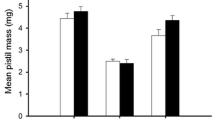Abstract
Populations ofRumex acetosa andR. acetosella were studied during two growth seasons. The ramet sex ratios ofR. acetosa were always female-biased. InR. acetosella the sex ratios expressed more variation but were mostly female-biased. In both species the sex ratios commonly varied between subpopulations reflecting a partial spatial segregation of the sexes. No marked differences between sexes in vegetative vigour were detected in either species. Interactions between sex ratios, various soil characteristics and population densities were determined. Possible mechanisms for causing biased sex ratios and partial spatial segregation of the sexes are discussed.
Similar content being viewed by others
References
Bawa, K. S., Opler, P. A., 1977: Spatial relationships between staminate and pistillate plants of dioecious tropical forest trees. — Evolution31: 64–68.
Bierzychudek, P., Eckhart, V., 1988: Spatial segregation of the sexes of dioecious plants. — Amer. Naturalist132: 34–43.
Conn, J. S., 1981: Phenological differentiation between the sexes ofRumex hastatulus: Niche partitioning or different optimal reproductive strategies? — Bull. Torrey Bot. Club108: 374–378.
Correns, C., 1928: Bestimmung, Vererbung und Verteilung des Geschlechtes bei den höheren Pflanzen. — Handb. Vererbungsw.2: 1–138.
Cox, P. A., 1981: Niche partitioning between sexes of dioecious plants. — Amer. Naturalist117: 295–307.
Escarré, J., Houssard, C., 1989: Variations de populations deRumex acetosella L. le long d'une succession secondaire: I. Allocation de biomasse. — Acta Oecologica/Oecol. Plant.10: 3–19.
—, —, Briane, J. P., 1987: Évolution du rapport des sexes de populations deRumex acetosella le long d'une succession postculturale. — Canad. J. Bot.65: 2668–2675.
Fisher, R. A., 1930: The genetical theory of natural selection. — Oxford: Oxford University Press.
Freeman, D. C., Klikoff, L. G., Harper, K. T., 1976: Differential resource utilization by the sexes of dioecious plants. — Science193: 597–599.
Harris, W., 1968: Environmental effects on the sex ratio ofRumex acetosella. — Proc. New Zealand Ecol. Soc.15: 51–54.
Herrera, C. M., 1984: The annual cycle ofOsyris quadripartita, a hemiparasitic dioecious shrub of Mediterranean scrublands. — J. Ecol.72: 1065–1078.
Holler, L. C., Abrahamson, W. G., 1977: Seed and vegetative reproduction in relation to density inFragaria virginiana (Rosaceae). — Amer. J. Bot.64: 1003–1007.
Lloyd, D. G., 1973: Sex ratios in sexually dimorphicUmbelliferae. — Heredity31: 239–249.
—, Webb, C. J., 1977: Secondary sex characters in plants. — Bot. Rev.43: 177–216.
Lovett Doust, J., Lovett Doust, L., 1985: Sex ratios, clonal growth and herbivory inRumex acetosella. — InWhite, J., (Ed.): Studies on plant demography: a Festschrift forJohn L. Harper, pp. 327–341. — London: Academic Press.
—, —, 1988: Modules of production and reproduction in a dioecious clonal shrub,Rhus typhina. — Ecology69: 741–750.
—, O'Brien, G., Lovett Doust, L., 1987: Effect of density on secondary sex characteristics and sex ratio inSilene alba (Caryophyllaceae). — Amer. J. Bot.74: 40–46.
Lovett Doust, L., Lovett Doust, J., 1987: Leaf demography and clonal growth in female and maleRumex acetosella. — Ecology68: 2056–2058.
Melampy, M. N., 1981: Sex-linked niche differentiation in two species ofThalictrum. — Amer. Midl. Naturalist106: 325–334.
—, Howe, H. F., 1977: Sex ratio in the tropical treeTriplaris americana (Polygonaceae). — Evolution31: 867–872.
Ogden, J., 1974: The reproductive strategy of higher plants. II. The reproductive strategy ofTussilago farfara L. — J. Ecol.62: 291–324.
Onyekwelu, S. S., Harper, J. L., 1979: Sex ratio and niche differentiation in spinach (Spinacia oleracea L.). — Nature282: 609–611.
Putwain, P. D., Harper, J. L., 1972: Studies in the dynamics of plant populations. V. Mechanisms governing the sex ratio inRumex acetosa andR. acetosella. — J. Ecol.60: 113–129.
—, Machin, D., Harper, J. L., 1968: Studies in the dynamics of plant populations. II. Components and regulation of a natural population ofRumex acetosella L. — J. Ecol.56: 421–431.
Rychlewski, J., Zarzycki, K., 1975: Sex ratio in seeds ofRumex acetosa L. as a result of sparse or abundant pollination. — Acta Biol. Cracov.18: 101–114.
Willson, M., 1983: Plant reproductive ecology. — New York: Wiley.
Winn, A. A., Pitelka, L. F., 1981: Some effects of density on the reproductive patterns and patch dynamics ofAster acuminatus. — Bull. Torrey Bot. Club108: 438–445.
Zimmerman, J. K., Lechowicz, M. J., 1982: Response to moisture stress in male and female plants ofRumex acetosella L. (Polygonaceae). — Oecologia53: 305–309.
Author information
Authors and Affiliations
Rights and permissions
About this article
Cite this article
Korpelainen, H. Sex ratio variation and spatial segregation of the sexes in populations ofRumex acetosa andR. acetosella (Polygonaceae). Pl Syst Evol 174, 183–195 (1991). https://doi.org/10.1007/BF00940339
Received:
Revised:
Accepted:
Issue Date:
DOI: https://doi.org/10.1007/BF00940339




